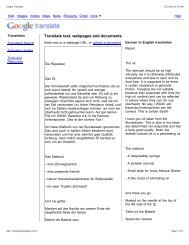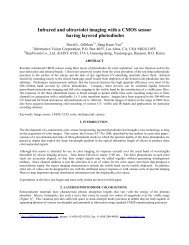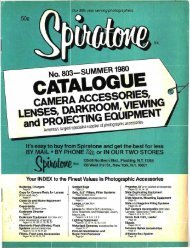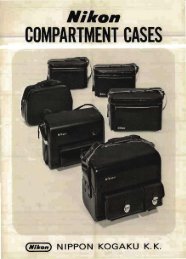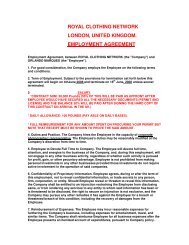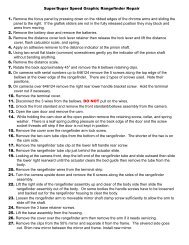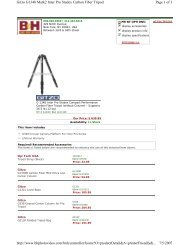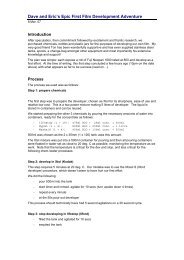Create successful ePaper yourself
Turn your PDF publications into a flip-book with our unique Google optimized e-Paper software.
from about f/192 to f/384, you should<br />
use a fast panchromatic film in order to<br />
be able to give shorter exposures. Color<br />
pictures can be made also with pinhole<br />
cameras. In color work, only tests will<br />
give you an idea of how to expose properly,<br />
and what filters to use.<br />
EXPOSURE: For a pinhole camera<br />
which has a "lens" made with a #10<br />
needle, and placed 5 inches from a fast<br />
panchromatic film, the following exposures<br />
might serve as a guide: (For best<br />
results run exposure tests. Shoot several<br />
shots, varying the time on each.<br />
Develop normally and choose the best<br />
negative for a standard of exposure.)<br />
Bright subject in full sunlight, 8 seconds,<br />
under thin clouds, 20 seconds: Average<br />
subjects, in full sunlight 16 seconds,<br />
under thin clouds, 40 seconds. Dark<br />
subjects, under full sunlight, 40 seconds,<br />
under thin clouds, 100 seconds. Indoors<br />
use two #2 photo-flood lamps, one on<br />
each side of the subject, pointed at it<br />
from 3 feet away. Expose 1 minute.<br />
PROCESSING: It is best to develop<br />
film by inspection. However, the above<br />
exposure guides are based on development<br />
in Kodak Dektol, diluted one part<br />
stock solution to three parts water, for<br />
4 min at 68-degrees F with agitation.<br />
VIEWFINDER: The most common way<br />
of judging what areas will be included<br />
in a picture made by a pinhole camera<br />
is to sight from the center, back part of<br />
the camera, at eye level, using the front<br />
corners of the camera to designate the<br />
right and left hand limits of the picture.<br />
By holding your hand about 4 or 5<br />
inches above the front section (this depends<br />
on whether you're taking a<br />
vertical or horizontal picture with your<br />
4x5 camera), you can get an approximate<br />
idea of your coverage.<br />
FOCUSING: Since the "lens" opening<br />
is somewhere within a few points on<br />
either side of f/200, you need not worry<br />
about focusing. Your picture will be as<br />
sharp in foreground as background.<br />
IMAGE SIZE: This depends primarily<br />
on the distance of the film from the pinhole.<br />
If the pinhole is 3 inches from a<br />
4x5 piece of film it will produce a wideangle<br />
effect. Using the sam~ film, but<br />
moving the .pinhole 5 inches away, you<br />
will get a view that could be classified<br />
as "normal." Using the pinhole beyond<br />
the normal focal length for 4x5 film will<br />
start producing a telephoto effect. You<br />
must remember that as you increase the<br />
focal length of your pinhole camera, that<br />
you are increasing the time of exposure<br />
also. If on a pinhole camera with a<br />
5-inch focal length the exposure in<br />
bright sunlight is 16 seconds, the exposure<br />
for a pinhole camera 10 inches<br />
long will be slightly more than 4 times,<br />
or about 70 seconds. For extra long pinhole<br />
cameras it is best to run exposure<br />
tests.<br />
SHUTTER: Since most pinhole exposures<br />
are long, a cardboard piece<br />
hinged over the front of the pinhole<br />
camera can act as a shutter. It is operated<br />
manually. With flash, electronic or<br />
flash bulbs, the duration of the light acts<br />
as the shutter. The open-flash system is<br />
used when working with flash. Open the<br />
shutter, fire, and then close it.-I!!!<br />
August. 1954





